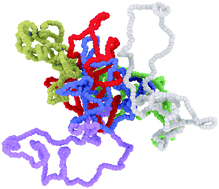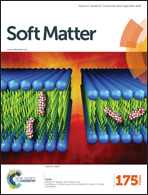On the tree-like structure of rings in dense solutions†
Abstract
One of the most challenging problems in polymer physics is providing a theoretical description for the behaviour of rings in dense solutions and melts. Although it is nowadays well established that the overall size of a ring in these conditions scales like that of a collapsed globule, there is compelling evidence that rings may exhibit ramified and tree-like conformations. In this work I show how to characterise these local tree-like structures by measuring the local writhing of the rings' segments and by identifying the patterns of intra-chain contacts. These quantities reveal two major topological structures: loops and terminal branches which strongly suggest that the strictly double-folded “lattice animal” picture for rings in the melt may be replaced by a more relaxed tree-like structure accommodating loops. In particular, I show that one can identify hierarchically looped structures whose degree increases linearly with the size of a ring, and that terminal branches are found to store about 30% of the whole ring mass, irrespectively of its length. Finally, I draw an analogy between rings in the melt and slip-linked chains, where contact points are enforced by mobile slip-links and for which a field-theoretic treatment can be employed to get some insight into their typical conformations. These findings are ultimately discussed in the light of recent works on the static structure of rings and on the existence of inter-ring threadings.


 Please wait while we load your content...
Please wait while we load your content...